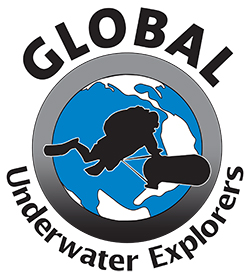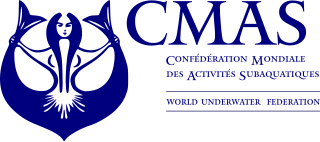A divemaster (DM) is a role that includes organising and leading recreational dives, particularly in a professional capacity, and is a qualification used in many parts of the world in recreational scuba diving for a diver who has supervisory responsibility for a group of divers and as a dive guide. As well as being a generic term, 'Divemaster' is the title of the first professional rating of many training agencies, such as PADI, SSI, SDI, NASE, except NAUI, which rates a NAUI Divemaster under a NAUI Instructor but above a NAUI Assistant Instructor. The divemaster certification is generally equivalent to the requirements of ISO 24801-3 Dive Leader.

Recreational diver training is the process of developing knowledge and understanding of the basic principles, and the skills and procedures for the use of scuba equipment so that the diver is able to dive for recreational purposes with acceptable risk using the type of equipment and in similar conditions to those experienced during training.

Recreational diving or sport diving is diving for the purpose of leisure and enjoyment, usually when using scuba equipment. The term "recreational diving" may also be used in contradistinction to "technical diving", a more demanding aspect of recreational diving which requires more training and experience to develop the competence to reliably manage more complex equipment in the more hazardous conditions associated with the disciplines. Breath-hold diving for recreation also fits into the broader scope of the term, but this article covers the commonly used meaning of scuba diving for recreational purposes, where the diver is not constrained from making a direct near-vertical ascent to the surface at any point during the dive, and risk is considered low.
Scuba Schools International (SSI) is a for-profit organization that teaches the skills involved in scuba diving and freediving, and supports dive businesses and resorts. SSI has over 2,500 authorized dealers, 35 regional centers, and offices all over the world.

Advanced Open Water Diver (AOWD) is a recreational scuba diving certification level provided by several diver training agencies. Agencies offering this level of training under this title include Professional Association of Diving Instructors (PADI), and Scuba Schools International (SSI). Other agencies offer similar training under different titles. Advanced Open Water Diver is one step up from entry level certification as a beginner autonomous scuba diver. A major difference between Autonomous diver equivalent Open Water Diver (OWD) certification and AOWD is that the depth limit is increased from 18 to 30 metres.

The Israeli Diving Federation (TIDF) is a non-governmental SCUBA diving training organization based in Israel.

The Scottish Sub Aqua Club (ScotSAC) was founded in Glasgow in 1953. Today it is a company limited by guarantee with nearly 70 branches and 1200 members. ScotSAC instructors provide scuba diving training to branch members on an amateur basis. It is recognised by sportscotland as the National Governing Body for Sub Aqua in Scotland.

The European Underwater Federation (EUF) is an umbrella organisation representing the interests of scuba diver training organisations operating in both the not for profit and for profit sectors within Europe.

Global Underwater Explorers (GUE) is a scuba diving organization that provides education within recreational, technical, and cave diving. It is a nonprofit membership organization based in High Springs, Florida, United States.

Confédération Mondiale des Activités Subaquatiques (CMAS) is an international federation that represents underwater activities in underwater sport and underwater sciences, and oversees an international system of recreational snorkel and scuba diver training and recognition. It is also known by its English name, the World Underwater Federation, and its Spanish name, Confederación Mundial De Actividades Subacuáticas. Its foundation in Monaco during January 1959 makes it one of the world's oldest underwater diving organisations.

A Diving certification or C-card is a document recognizing that an individual or organization authorized to do so, "certifies" that the bearer has completed a course of training as required by the agency issuing the card. This is assumed to represent a defined level of skill and knowledge in underwater diving. Divers carry a qualification record or certification card which may be required to prove their qualifications when booking a dive trip, hiring scuba equipment, having diving cylinders filled, or in the case of professional divers, seeking employment.

Open Water Diver (OWD) is an entry-level autonomous diver certification for recreational scuba diving. Although different agencies use different names, similar entry-level courses are offered by all recreational diving agencies and consist of a combination of knowledge development (theory), confined water dives and open water dives (experience) suitable to allow the diver to dive on open circuit scuba, in open water to a limited depth and in conditions similar to those in which the diver has been trained or later gained appropriate experience, to an acceptable level of safety.
The Nederlandse Onderwatersport Bond, (NOB) is the national governing body for recreational diving and underwater sports in the Netherlands. It was founded in 1962. In 2008 there were 290 scuba diving clubs and schools with a total of 20.000 members. The NOB is a member of CMAS Confédération Mondiale des Activités Subaquatiques. The aim of the NOB is to develop recreational scuba diving in the Netherlands.

A diving instructor is a person who trains and usually also assesses competence of underwater divers. This includes freedivers, recreational divers including the subcategory technical divers, and professional divers which includes military, commercial, public safety and scientific divers.

Autonomous diver is an international minimum standard for entry level recreational scuba diver certification. It describes the minimum requirements for basic training and certification for recreational scuba divers in international standard ISO 24801-2 and the equivalent European Standard EN 14153-2. Various organizations offer training that meets the requirements of the Autonomous Diver standard. A certification which corresponds to Autonomous Diver allows for independent diving with a dive buddy in open water. Most training organizations do not recommend exceeding a depth of 18 or 20 meters at this level of certification. After completion of this certification the training can be extended to a dive leader to ISO 24801-3 or an intermediate not defined by international standards.
Dive leader is the title of an internationally recognised recreational diving certification. The training standard describes the minimum requirements for dive leader training and certification for recreational scuba divers in international standard ISO 24801-3 and the equivalent European Standard EN 14153-3. Various organizations offer training that meets the requirements of the dive leader standard. Some agencies use the title "Dive Leader" for their equivalent certification, but several other titles are also used, "Divemaster" may be the most widespread, but "Dive Supervisor" is also used, and should not be confused with the very different status and responsibilities of a professional diving supervisor. CMAS affiliates certifications which meet the requirements of CMAS 3-star diver should meet the standard by default. The occupation of a dive leader is also known as "dive guide", and is a specialist application of a "tour guide".

The history of scuba diving is closely linked with the history of the equipment. By the turn of the twentieth century, two basic architectures for underwater breathing apparatus had been pioneered; open-circuit surface supplied equipment where the diver's exhaled gas is vented directly into the water, and closed-circuit breathing apparatus where the diver's carbon dioxide is filtered from the exhaled breathing gas, which is then recirculated, and more gas added to replenish the oxygen content. Closed circuit equipment was more easily adapted to scuba in the absence of reliable, portable, and economical high pressure gas storage vessels. By the mid-twentieth century, high pressure cylinders were available and two systems for scuba had emerged: open-circuit scuba where the diver's exhaled breath is vented directly into the water, and closed-circuit scuba where the carbon dioxide is removed from the diver's exhaled breath which has oxygen added and is recirculated. Oxygen rebreathers are severely depth limited due to oxygen toxicity risk, which increases with depth, and the available systems for mixed gas rebreathers were fairly bulky and designed for use with diving helmets. The first commercially practical scuba rebreather was designed and built by the diving engineer Henry Fleuss in 1878, while working for Siebe Gorman in London. His self contained breathing apparatus consisted of a rubber mask connected to a breathing bag, with an estimated 50–60% oxygen supplied from a copper tank and carbon dioxide scrubbed by passing it through a bundle of rope yarn soaked in a solution of caustic potash. During the 1930s and all through World War II, the British, Italians and Germans developed and extensively used oxygen rebreathers to equip the first frogmen. In the U.S. Major Christian J. Lambertsen invented a free-swimming oxygen rebreather. In 1952 he patented a modification of his apparatus, this time named SCUBA, an acronym for "self-contained underwater breathing apparatus," which became the generic English word for autonomous breathing equipment for diving, and later for the activity using the equipment. After World War II, military frogmen continued to use rebreathers since they do not make bubbles which would give away the presence of the divers. The high percentage of oxygen used by these early rebreather systems limited the depth at which they could be used due to the risk of convulsions caused by acute oxygen toxicity.

The following outline is provided as an overview of and topical guide to underwater diving:
Recreational scuba certification levels are the levels of skill represented by recreational scuba certification. Each certification level is associated with a specific training standard published by the certification agency, and a training programme associated with the standard., though in some cases recognition of prior learning can apply. These levels of skill can be categorised in several ways:












